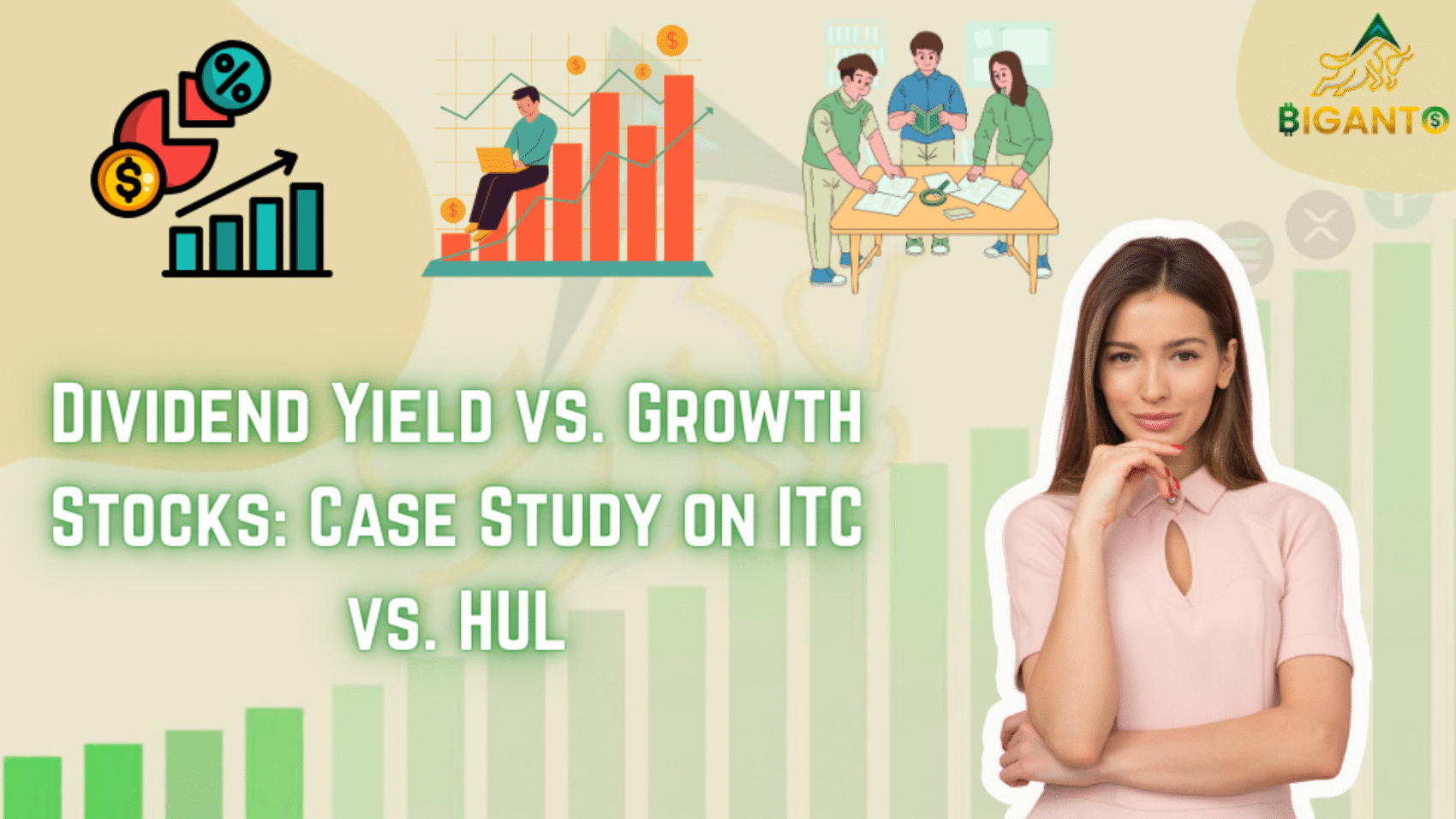Introduction
Investors in the Indian stock market frequently struggle with basic confusion Should they focus on long-term capital growth tomorrow or regular, reliable income today?
The argument between growth and dividend yield equities revolves around this trade-off. Generally speaking, investors are aware of a stock’s dividend yield. A portion of a mature company’s periodic free cash flow is usually distributed as dividends.
Dividend-paying companies have historically had slow growth, but their ability to consistently create free cash flow and their dedication to paying dividends have allowed them to beat the market. In general, investors are not as familiar with the Yield on Cost (YOC) idea. YOC evaluates a stock’s dividend yield by taking into account the stock’s initial acquisition price. Dividend yield and yield on capital (YOC) may be the same for businesses that pay unchanging dividends. Nonetheless, the YOC often increases over time for businesses that pay increasing dividends (also known as Dividend Growth companies).
To demonstrate this dynamic, we examine two of India’s most well-known and esteemed corporations, ITC Ltd. and Hindustan Unilever Ltd. (HUL), in this case study. ITC is a prime example of the dividend yield investment strategy, appealing to income-focused investors with its diverse portfolio and track record of large dividend payments. HUL, a pure-play FMCG leader that reinvests its profits to build its brands and market position, on the other hand, is a prime example of the growth stock approach and attracts investors looking for consistent capital compounding.
Comparing Dividend Growth Stocks and High Yield Stocks
In the Indian stock market, the debate between high yield stocks and dividend growth stocks comes down to balancing immediate income against long-term compounding potential.
High Yield Stocks: ITC, for instance
Generally speaking, high yield stocks pay out more dividends than their share price. Strong free cash flow generation may be the cause of this, although financial engineering or a dropping stock price may also be the cause. In these situations, a larger yield may also entail greater risk and volatility.
High ratios of payout – A significant amount of the free cash flow of many high yield companies is distributed as dividends, which reduces the amount available for reinvestment or continuing payouts during downturns.
Payouts financed by debt – Leverage and long-term risk are raised when dividends are maintained or raised by the issuing of debt.
Risk of dividend cuts – These elements may compel businesses to reduce dividends during difficult times, which lowers revenue and frequently results in a decline in share price.
On the other hand, ITC is a high-yield stock that is supported by robust operating cash flows from its core operations. ITC has maintained a reputation for reliable payouts and is well-known for its regular interim, final, and sporadic special dividends. Income-focused investors keep a careful eye on ITC’s dividend yields, which fluctuate with share price and are currently around 1.54%. They increase when the price declines.
Dividend Growth Stocks: HUL, for instance
Although dividend growth stocks typically have a lower initial yield, long-term investors may benefit from their greater Yield on Cost (YOC) due to their capacity to expand dividends steadily over time. This expansion is frequently aided by:
Reduced payout ratios – Making it possible to put profits back into growth and new product development.
Low leverage and robust balance sheets – It give the ability to maintain and increase dividends even in times of economic crisis.
Better risk-adjusted returns – Because of their solid business strategies and diverse revenue streams, they have less volatility than their high yield peers.
HUL is the ideal fit for this profile. Being the industry leader in personal care and domestic goods, it continuously reinvests profits to grow its franchise, create new goods, and increase its market share. Because a large portion of its value comes from capital appreciation rather than large immediate payouts, its yield is still lower than ITC’s despite its dividends being consistent and increasing. HUL is appealing to investors looking for compounding income streams because of its consistent dividend increases, which over time can greatly boost an investor’s year-over-cost.
ITC vs HUL (Q3 FY25 & Dividend Yields)
Dividend Yield & Policy:
ITC
1.54% at a share price of ₹422 (interim dividend of ₹6.5/share declared in Q3). Known for high dividend payouts relative to many peers; has declared combined dividends (interim + final + occasional special) in recent years, with multiple interim and final payments in FY24–25.
HUL
1.23% at a share price of ₹2,362.10. Pays regular semi-annual dividends but historically offers a lower yield than ITC. Continues to raise payouts in line with earnings and enjoys a reputation as a steady-growth consumer franchise.
Q3 FY25 Earnings
ITC – Standalone net profit up 1% YoY to ₹5,638 crore (beat estimates); consolidated net profit down 7% to ₹5,013 crore; revenue up to ₹20,350 crore from ₹18,880 crore a year ago.
HUL – Net profit up 19% YoY to ₹3,001 crore; revenue at ₹15,818 crore (up 1.6% YoY); EBITDA margin steady at 23.5%.
Comparative Analysis
Dividend Yield HUL
Lower Yield In comparison to ITC, HUL has a moderate dividend yield, now at 2.2%. Instead of paying out the majority of its profits as dividends, the corporation reinvests a greater percentage of its earnings back into growth efforts. Although this method provides less immediate income, it is better for long-term compounding.
Dividend Yield ITC
Greater YieldBy large-cap FMCG norms, ITC pays a dividend yield of 3.4%+. It regularly distributes interim, final, and sporadic special dividends. ITC’s return is a significant benefit for retirees, conservative investors, and those seeking consistent passive income.
HUL – Higher P/E
Due to its market supremacy, brand domination, and steady development trajectory, HUL demands a premium valuation, trading at a P/E of 52x. When it comes to projected earnings stability and growth potential, investors are prepared to pay more.
ITC Lower P/E
ITC trades at a significantly lower P/E of roughly 15x, in part because of slower growth in its FMCG market share and outdated perceptions about its tobacco business. Nonetheless, investors benefit from a larger dividend yield and maybe less downside risk during market falls due to this cheap valuation.
HUL – Historically More Powerful
HUL’s excellent profits growth and market premium have allowed it to achieve a higher compound annual growth rate (CAGR) in share price over the past ten years than ITC. Compounding has been quite advantageous for investors who have held for extended periods of time.
ITC: More Moderate
Historically, ITC’s stock price growth has been slower because of the burden of tobacco legislation issues and the timeliness of the FMCG industry’s ramp-up. However, thanks to re-rating and the growth of the FMCG contribution, ITC has seen improved price momentum in recent years.
Conclusion
This case study demonstrates that understanding a company’s investment philosophy, not just its brand name, is crucial for making informed decisions that align with one’s personal financial goals. ITC’s higher dividend yield, diversified revenue streams, and consistent payout policy make it an obvious choice if you seek defensive returns and steady cash flows.
Compounding, HUL’s growth-driven reinvestment strategy, and historical capital appreciation potential can all produce better long-term wealth creation outcomes if you give them top priority.

